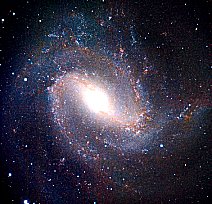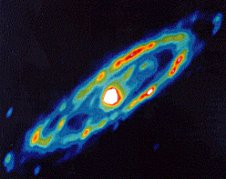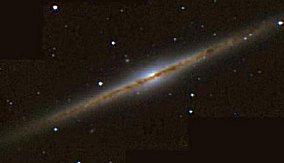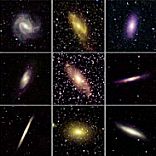



|
|
The infrared emission from galaxies comes primarily from three sources: stars, interstellar gas, and dust. The emission from stars peaks in the near-infrared (1-3 microns). Emission from atoms and molecules in interstellar gas makes up only a few percent of the infrared output of galaxies. The primary source of infrared radiation beyond 3 microns is thermal emission from dust grains heated by starlight.

The brightest infrared galaxies are
usually the ones which have a lot of dust (in star-forming regions
for example).
Astronomers using the
IRAS satellite observed 20,000 galaxies in the infrared.
Many of these were starburst galaxies - galaxies which are
forming enormous numbers of new stars, and are thus extremely bright in the
infrared. Further infrared studies of these galaxies may find
the cause of this star-forming frenzy. At the left is an infrared image of
the starburst galaxy M83.
Spiral galaxies, which are rich in gas and dust, are strong infrared sources
and are still forming new stars. About half of the luminosity of an average
spiral galaxy is radiated at far-infrared
wavelengths. Elliptical galaxies are faint in the infrared because they no
longer have much gas and dust.
Below are infrared images of three galaxies. To the left is an infrared image, taken by the IRAS satellite, of the Andromeda galaxy. Notice the regions where young stars are forming shown in yellow and red. The middle image shows an infrared view of the barred spiral galaxy NGC 1365. In this image you can more clearly see the the bright areas of star formation, as well as young star clusters. Taken in 1999, this image shows the improvement in resolution since the days of IRAS (sixteen years earlier). To the right we have an infrared view of the edge on spiral galaxy NGC891. Here you can clearly see the lanes of dust along the edge of the galaxy.



Infrared images of the Andromeda galaxy (NASA/IPAC/IRAS),
the barred spiral galaxy NGC 1364
(C. Marcella Carollo (JHU, Columbia U.), NASA, ESA), and
the edge-on spiral galaxy NGC 891 (J. C. Barentine (PSI) et al., KPNO, NOAO).

Infrared View of the 30 Largest Galaxies (2MASS) |
During December 1995, the Hubble Space Telescope scanned a small area of the
sky to make the deepest image of the sky ever - this area is called the
Hubble Deep Field.
In 1996, Astronomers using
ISO found that many of the faint galaxies
detected by the Hubble Space Telescope in the Hubble Deep Field radiate most
of their energy in the infrared and are going through a period of very
active star formation.
Recently, several new galaxies were discovered behind the
Milky Way in near-infrared
2MASS images.
To view other infrared galaxies see the 2MASS Gallery and the Hubble's Infrared Galaxy Gallery |
|
|